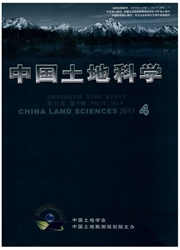

 中文摘要:
中文摘要:
研究目的:建立农地非农化与人类经济活动、人口增长的非线性动力学模型。研究方法:数学建模与数值模拟。研究结果:(1)当农地承载力较大时,可持续利用的土地资源总量可维持在一个较低的水平,农地非农化水平较高。(2)过度的农地非农化、低效率土地资源利用等一些减小资源承载力的人类活动,都将导致人口-土地资源系统作较快的非周期运动,而剧烈的变化意味着灾变。(3)农地非农化水平一定时,提高经济发展水平,可促使土地资源持续利用。(4)当前,大量的农地被非农化,提高土地资源承载力尤为重要。研究结论:农地非农化一人口增长一经济发展是一个复杂非线性系统,不同的土地利用和人口发展方向,将形成不同的平衡态,进而导致系统演化趋势迥异。
 英文摘要:
英文摘要:
The purpose of the paper is to establish a nonlinear model of dynamic evolution of the relation between agricultural land conversion and human activities. Method of modeling was employed. The results show that: (1) the gross land resource in sustainable use can be at a low level if the agricultural land conversion rate and the supporting capacity are at a high level. (2) excessive agricultural land conversion and low efficiency use of land resource will bring about severe non-periodic change of the system, which will be disastrous. (3) the economic development will improve the sustainable use of land resource when the conversion rate of agricultural land is fixed. (4) it is very important to improve the level of land supporting capacity when the rate of conversion is high at present. The conversion of agricultural land, population growth and economic development can be a complicated non-linear system. Different land use and population growth will form different state of balance which will lead to varying dynamic evolution of the system.
 同期刊论文项目
同期刊论文项目
 同项目期刊论文
同项目期刊论文
 期刊信息
期刊信息
